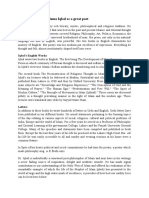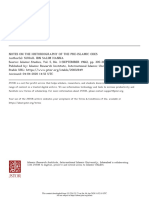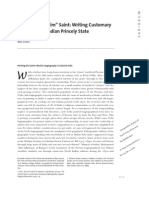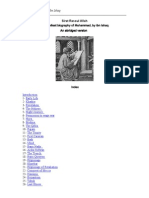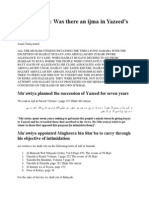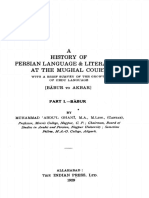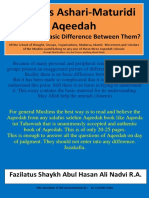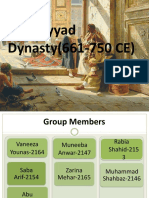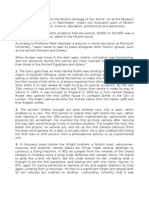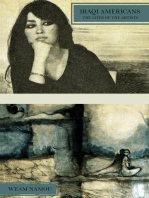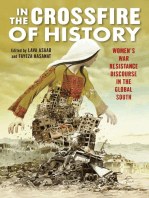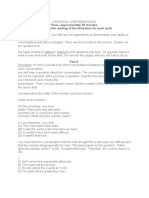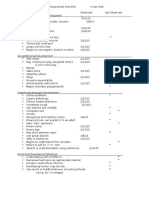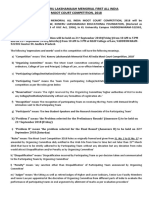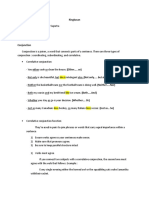Mahjar Poets
Mahjar Poets
Uploaded by
mohammedaldaqs4614Copyright:
Available Formats
Mahjar Poets
Mahjar Poets
Uploaded by
mohammedaldaqs4614Copyright
Available Formats
Share this document
Did you find this document useful?
Is this content inappropriate?
Copyright:
Available Formats
Mahjar Poets
Mahjar Poets
Uploaded by
mohammedaldaqs4614Copyright:
Available Formats
CLASSICAL ELEMENTS IN MAHJAR POETRY
SULAIMAN JUBRAN
Tel-Aviv University
Abstract
Mahjar poets, particularly members of al-Rbiah al-qalamiyyah, established a new romantic school that exercised an immense inuence on modern Arabic poetry as a whole. Most of the scholars who have studied this poetry have put excessive emphasis on its Christian components, minimizing, if not altogether ignoring, Islamic and classical elements. This article examines whether this attitude is warranted, by investigating in detail the poetry of Nasb Arah, a prominent representative of that school. It turns out that Christian sources are infrequent in Arahs poetry, whereas Islamic and classical sources predominate. I conclude that the generalization about the primacy of Christian culture in the works of the alRbiah group is of doubtful validity, and that further investigations similar to this study are needed.
Mahjar poetry, especially the poetry written by Arab emigrant poets in the United States during the early years of the twentieth century, is generally credited with having made a unique contribution to the rejuvenation of modem Arabic poetry. Thanks in particular to the literary output of members of al-Rbiah al-qalamiyyah,1 emigrant poets are seen as having successfully established a new, romantic school of writing that differed markedly from the neo-classical qadah, still dominant at the time in the Middle East. The fact that all members of al-Rbiah were Christians, some having received their education at missionary schools, has prompted many scholars to claim that Christian culture was at the root of their innovative efforts and to highlight the specically Christian features and motifs that can be found in their poetry. Anas Dwd says, for example: The Gospel, Christian religious teachings, and what they inherited from their bigoted Christian surroundings became rmly lodged in the minds of Mahjar poets, and are reected in their poetry, for good and bad.2 So prevalent has this attitude
For details about al-Rbiah, see Mkhl Nuaimah, Jubrn Khall Jubrn (Baskinta, 1934), pp. 157-162; Is al-Nr , Adab al-Mahjar (Cairo, 1967), pp. 21-26. 2 Anas Dwd, al-Tajdd f Shir al-Mahjar, (Cairo,1967), p. 58. (Unless otherwise indicated, this and further translations are mine.) See also, M.M. Badawi, A Critical Introduction Koninklijke Brill NV, Leiden, 2007 Also available online www.brill.nl Journal of Arabic Literature, XXXVIII,1
1
68
SULAIMAN JUBRAN
become that the works of these poets are often summarily dubbed Christian poetry. The Christian background of al-Rbiah poets is of course undeniable, as are Christian inuences which can be traced in their works. However, as I will argue below, Christian lore is neither the exclusive nor even the principal component of the overall intellectual background which al-Rbiah poets had in common. In other words, scholarly preoccupation with the Christian features of the al-Rbiah school has led to a neglect of all other constituent elements of their literary output. This woefully lopsided view can be balanced with the following question: How likely is it that a group of Arab poets anywhere would be able to produce Arabic poetrywith its attendant rules of diction, grammar and prosodywhile effecting a complete rupture with their Arabic literary heritage? In the case of the al-Rbiah group, would it have been conceivable, let alone possible or practical, for them to excise from consciousness the totality of classical and neo-classical poetry they had learned and assimilated in their childhood and youth through formal education and informal cultural practice? It may be instructive to reexamine the validity of this thesis by focusing on the works of one of the prominent poets of the al-Rbiah group, Nasb Arah. Arah (1887-1946) was born in the city of Homs (im) in Syria and received his elementary education in one of the Russian schools there; he then moved to Nazareth where he studied for ve years (1900-1905) in the Russian Teachers Training College. In Nazareth he made the acquaintance of Mkhl Nuaimah (1889-1988) and Abd al-Mas addd (1890-1963). The three would eventually become members of al-Rbiah in New York in 1920. In 1905, Arah emigrated to the United States, where, in 1912, he established the Atlantic Press and later founded a periodical, alFunn, which published primarily Mahjar literature written by al-Rbiah members. In 1918, after having had to close the journal, Arah tried his hand at business but, when this too failed, he again tried to make a living from his writings. As noted above, he died in 1946 in New York. Arah was never able to escape nancial hardship, while privately he lived a life of solitude characterized, like his poetry, by much sorrow and pain.3 His poems were published posthumously in 1946, in a volume of almost 300 pages entitled al-Arw al-irah (Bewildered Spirits), containing a total of 95 poems.4 Most of these poems evince a deeply romantic sensibil-
to Modem Arabic Poetry (Cambridge, 1975), pp. 179-185; S. Moreh, Modem Arabic Poetry, 1800-1870 (Leiden, 1976), pp. 82-122. 3 Further details on Arah: Ndirah Sarrj, Nasb Arah, (Cairo, 1970), pp. 23-37; AlNr, pp. 408-420; Badawi, pp. 191-195. 4 Nasb Arah, al-Arw al-irah, (New York, 1946).
CLASSICAL ELEMENTS IN MAHJAR POETRY
69
ity bent on depicting the sadness of life, the confusion, poverty, misery and loneliness inherent therein. The entire collection reects both the unfortunate circumstances of Arahs personal life and the unmistakably romantic attitude towards life and human fate which he exemplied.5 In this and other respects, Arahs dwn, perhaps more than any other al-Rbiah poetry collection, can be taken as representative of the entire Mahjar school in Northern America. Before examining this remarkable dwn in greater detail, especially as regards its outstanding use of imagery, Christian and classical alike, three preliminary remarks are in order. First, in the second half of the nineteenth century, the Middle East, especially Lebanon and Egypt, witnessed a signicant revival of the classical Arabic heritage, in what literary historians have come to call arakat iy al-turth (Movement for the Revival of the Classical Heritage). Printing presses were established, libraries created and literary associations formed, all of which led to an upsurge in the publication of many classical works, including poetry from the so-called Golden Age.6 In other words, the literary environment in Lebanon at the turn of the twentieth century was anything but divorced from, or oblivious to, classical poetry. Secondly, Arah studied for ve years at the Russian Teachers Training College in Nazareth. There, he became acquainted with the Arabic language and literature, both poetry and prose, of the classical age, including grammar and prosody.7 These ve years of study no doubt gave him a solid grounding that he would be able to exploit later when he turned to writing poetry following his immigration to the United States. Finally, there is Arahs documented endeavor of continuous self-education. Sarrj says that throughout his life in America Arah read American or English literature much less than any member of al-Rbiah; rather, he spent all his time in reading Arabic in the Arabic Section of the New York Public Library.8 When Arahs stylistic characteristics are examined more closely, Christian inuences are scant, especially when compared with their Islamic and classical counterparts. In the three-hundred or so pages of Arahs great collection Arw, I was unable to nd more than ve or six allusions to Christian lore:
5 About his miserable life, see Ndirah Sarrj, Shuar al-rbiah al-qalamiyyah (Cairo, 1964), pp. 350-353; Badawi, p. 192. 6 See Jurj Zaidn, Trkh db al-Lughah al-Arabiyyah (Beirt,1967), vol. 4; ann alFkhr, al-Jmi f Trkh al-Adab al-Arab, al-Adab al-adth (Beirt, 1986) pp. 7-20. 7 See Mkhl Nuaimah, Sabn, vol. 1, pp. 122-124, 143-145. 8 Sarrj, Nasb Arah, pp. 50, 141; Arah, p. 10.
70
SULAIMAN JUBRAN
a) In a poem called Sallat fawkih (Fruit basket),9 the fruit the poet sees in the basket evokes images of King Solomon and the Shulamite woman from the Song of Songs. The verse that opens this broad allusion is:
(I imagined I heard the voice conveying to me / the echo of the Song of Songs love poetry / and a scene with King Solomon that I could contemplate.) b) In another poem, entitled alt al-amwt (Prayer for the Dead),10 he exhorts the reader to pray also for repentant mmis (prostitute), a clear and direct allusion to Christ and Mary Magdalene:
(One like her walked with Christ / yet how often did people stone her by aspersion.) c) A third allusion to Christianity, this time to the cross as a symbol of suffering, appears in Al al-arq (On the road),11 a gurative portrayal of human life:
(Though burdened by the cross of time / we prevailed over our misery thanks to our hopes.) d) Another reference to Christian tradition, this time to King Davids Psalms, is found in the rst verse of the poem Allaqtu d (I Hung My Lute):12
9 10 11 12
Arah, pp. 91-96. Ibid., pp. 156-160. Ibid., pp. 61, 120, 186, 188. Ibid., p. 138; see also Moreh, p. 90.
CLASSICAL ELEMENTS IN MAHJAR POETRY
71
(I hung my lute upon the willow of despair / and began to lament mankind in my solitude.) e) One other Christian symbol appears in Arahs long philosophical poem Al arq Iram (On the Way to Iram), where the Transguration of Christ is employed to symbolize the meeting with the Spiritual World:13
(Let us ascend the Mount of Transguration / and receive light on the summits. / When we climb up through the dele / we come near to God.) These ve allusions to Christian culture in Arahs dwn, few enough even in absolute terms, are truly negligible in the context of a collection containing 286 pages and composed by one of the most prominent Christian members of al-Rbiah al-qalamiyyah. In contrast, there are in the same collection many clear instances of Islamic and classical symbols and allusions, an indication of just how well versed Arah was in classical Arabic heritage and its concomitant Islamic culture. Some of these allusions are: a) An Islamic symbol that appears a number of times in Arahs dwn is Iram. The poet claries the title of the last-mentioned poem above, Al arq Iram (On the Way to Iram),14 in a preliminary comment: Arab legend has it that Iram dht al-imd was a marvelous city built by Shaddd ibn d out of golden stones, pearls and jewels. It was such a fascinating and dazzling place that no one who went there could behold it from a distance when it was facing the sunlight. The name of the city occurs in the Qurn as well,15 but the poet cites only the Arab legends and uses Iram in a new romantic context, as the symbol of a spiritual city which he has set out to reach with his caravan. Eventually, he is able observe its radiance from a distance, but is unable to enter it. Iram occurs again in a poem called al-Musr (The Traveler),16 with the same symbolic function. Addressed to his friend, W. Katsis, another
13 14 15 16
Ibid., p. 194. Ibid., pp. 177-197. Qurn, al-Fajr, 82/7. Arah, pp. 113-115.
72
SULAIMAN JUBRAN
member of al-Rbiah, who decided to travel to China, the poem contains the lines:
(The best route is through the unknown regions / which conceal the way to Iram. / If you reach its palaces / they will make you forget hunger and pain.) b) The Quranic angel Hrt17 is also mentioned in a poem called adth al-shir (The Poets Discourse):18
(. . . from the maidens beauty, in its seductiveness, Hrt did abhor the anticipation of eternity.) c) What is perhaps even more surprising is the use Arah makes of references to many Islamic concepts and terms in a poem dedicated to New York:19
...
(Here is a Kabah to which people make pilgrimage / every day, and nothing here is prohibited. / Here is the Kabah of aspirations, inside / is the desired stone (= The Black Stone) that everyone can kiss. / Here you feel the sanctity of the circumambulation [around the Kaba] and of drinking from Zamzam (= a sacred well in Mecca). New York, that quin-
17 18 19
Qurn, al-Baqarah, 2/102. Arah, p. 17. Ibid., pp. 270, 272; see also p. 172.
CLASSICAL ELEMENTS IN MAHJAR POETRY
73
tessential representative of Western civilization, is depicted in unexpected, if not ironic, terms. d) Other terms, relating to resurrection in Islam, for example yawm al-dn, nushr, bq al-nushr and nafkh al-r, are employed in Arahs poetry more than once, for example:20
(Sleeping people may think your sigh / to be the trumpet of Resurrection on Judgment Day). Other Quranic expressions, such as quf dniyah, sidrat al- muntah and zaqqm,21 are utilized too. e) The last example is perhaps the most astonishing. In his poem Nashd al-muhjir (The Emigrants Chant), the Christian Orthodox poet states frankly:22
(In Palestine are my sanctuaries, my sentiments / in Najd, and the magnanimous Qiblah (= the Kabah) is my faith). The second category, of classical heritage, comprising literary gures, images and expressions, is by far the most dominant of all stylistic features in Arahs poetry. His dwn is unmistakably romantic, yet he manages to derive abundant elements from classical sources. He then employs these elements guratively in the new romantic context in which he embeds them. First, there are the classical gurespoets and eminent personalities in classical history in general. In the poem al-adq (The Friend), for example, Arah portrays the ideal friend he longs for, and after enumerating all his attributes, compares this friend to two classical poets, one known as a wine poet, the other as a brave knight:23
20 21 22 23
Ibid., Ibid., Ibid., Ibid.,
p. 87; see also pp. 125, 155, 195. pp. 95, 123, and 271, respectively. p. 248. p. 27. About other classical gures see also, pp. 75, 231, 254.
74
SULAIMAN JUBRAN
(When drinking wine, he is like ar-al-Ghawn [an alias of the Abbasid poet Muslim ibn al-Wald], / but when it comes to ghting, he is like Amr ibn Mad[karib]. It is signicant to note that as this poem laments the loss of moral standards in modern times, it turns for ideal friendship in drinking, companionship and courage in battle to those exemplary classical poets. Secondly, there are also many allusions to classical literature, especially poetry. Two references, for example, are made to riq ibn Ziyd, the conqueror of Spain, and to the famous speech24 he gave to his soldiers before ghting erupted:25
(We reach the port of fortune, then we burn the ships) (One dried date, when Im hungry in the desert, is sweeter to my taste than all the delicacies at the table of ignoble people.) Moreover, in a poem entitled Ghdat al- (the young girl of the ), Arah alludes in a single stanza both to al-Mutanabb (915-965) and to Dk al-Jinn, (777-849):26
(You have the beauty of the Bedouin and of civilization joined together / So you tempted Dk al-Jinn, the poet, woe unto your father! / It is killing glances you throw, not your fathers swords / that eliminated him and turned him into your love martyr.)
For more details on that speech, see liyya w, Fann al-Khibah wa Taawwuruh ind -al-Arab (Beirt n.d.), pp. 472-474. 25 Aah, pp. 131, 275, respectively. 26 Ibid., p. 258; see also p. 274.
24
CLASSICAL ELEMENTS IN MAHJAR POETRY
75
Thirdly, Abbs and Najm, in their study on northern Mahjar poetry, rightly state that Nasb uses desert images very frequently [. . .]. The axis of most of his symbols is the caravan, and his journey is by and large a desert one.27 Motifs of the desert environment are scattered throughout Arahs collection, in different gurative contexts. Motifs such as rakb/qlah (caravan), al-d (caravan leader/singer), all (deserted campsite), dall (guide), an/iml (howdah), sarb/l (fata morgana), harq al-wib (to shed the milk-skins), al-im/al-rab (homeland), and many others, all used in a primarily gurative way, abound in Arahs dwn. Sufce it to cite one short specimen of two lines only, in order to illustrate how general these motifs are and how frequently they appear. In a poem entitled Al al-all (At the Deserted Campsite), the rst stanza begins:28
(The abode of affection and delity, oh my two companions [in the duad!] has been extinguished. / Turn to its remains and there stop with your hearts). This pair of lines brings together many of the terms associated with the all motif: ibayya (in the dual), afa, rab, ja, all, qif. Finally, I want to consider two poems separately, because of their tight connections with classical poetry. The rst poem, Itir Ab-Firs (The Last Breath of Ab-Firs), is composed of nine sections, on nine full pages, and is intended to dramatize the nal hours of Ab-Firs, who died in exile.29 The rst three sections, consist of a single qadah of twenty verses, with monometer and monorhyme, exactly as required by classical poetry, but the division into three sections is intended to reect the poets varying physical and psychological states. Unlike N. Sarrj who classies this poem as dramatic (qadah tamthliyyah),30 I would argue that this is, at the very most, an interesting experimentation in depicting the changing moods of the poet in his last hours, through an extended monologue whose poems, all varying in meter and rhyme, reect the psychological aspects of his nal journey. The poem is very much in the classical style, and in all its details reveals the poets familiarity with the life and poetry of Ab-Firs. Arah cites
27 Isn Abbs and Muammad Najm, al-Shir al-Arab f al-Mahjar (Beirut, 1967), pp. 213-214. 28 Ariah, p. 74; see also pp. 73, 88, 126, 130, 182, 188, 274. 29 Ibid., pp. 211-219. 30 Sarrj, Naib Arah, p. 114.
76
SULAIMAN JUBRAN
twelve verses from three of Ab-Firs poems,31 and shows that he is entirely at home in the works of Ab-Firs. The second poem, Y nafs (Oh My Soul),32 is a remarkable qadah in a strophic structure whose thirty stanzas contain four hemistiches each, in majz al-kmil meter with the rhyme scheme AAAB, the last rhyme serving as a refrain throughout the entire poem. Pervasively sad in its romantic questioning tone, this long poem obviously expresses the doubts and suspicions the poet endured with regard to his soul. At the same time, it illustrates, on the whole, the dominant concepts of al-Rbiah concerning the soul, the body, death and eternity. Arah himself had touched on the theme of the soul in other poems,33 but since this is only one poem in all Mahjar poetry to deal with the philosophical issue in such a comprehensive and profound way, it has become probably one of his most frequently quoted. Although Y nafs unquestionably represents a romantic innovation in theme and style, its stylistic connection with classical poetry and Islamic culture is undeniable, as is the case with most of Arahs poetry. Again, there are many classical and Islamic expressions and motifs: bq al-nushr (the trumpet of Resurrection), yawm al-dn (Judgment Day), rakb (caravan), al-im | al-rub (homeland), adm (skin, body), harq alwib (to shed the milk-skins), ral (saddle), sarb | l (fata morgana), uwm (thirst), umma al-qa (death came). But even more signicant is the direct inuence, in style and substance, of the classical poem Al-nafs by Ibn Sn/Avicenna (980-1037).34 Although the two poems are different in meter and rhymeArahs is a strophic poem in majz al-kmil, while Ibn-Sns has a classical structure with the full kmil metre and a monorhyme a substantial resemblance can easily be observed between them.35 The soul, in both poems, is depicted as a dove that has descended from some sublime place and unwillingly entered the body on earth. The body can only be a prison for the soul, which therefore will not stop lamenting until it is again released and can return to its former homeland. Both poems express this journey in identical wordings. In Ibn Sns poem, there are: warq ( pigeon), hub (descending), buk (crying), al-im (homeland), sharak/qafa (cage); while Arah uses: hammah (pigeon), hub (descending), naw (lamentation), al-im/al-rub (homeland), sijn al-adm (the prison of the body). It would be fascinating to quote and compare both IbnSns and Arahs poems in detail, but here, too, a brief quote from
31 Ab Firs al-Hamdn, Dwn Ab Firs al-Hamdn, (Beirut, 1993), pp. 63-64, 177-183, 267-268. 32 Ariah, pp. 87-90. 33 See for example Il nafsi, pp. 104-106; Y nafs l tabk, pp. 149-150. 34 Muhammad Kmil al-Hurr, Ibn Sn (Beirut, 1991). Pp. 74-76. 35 See also, Abbs and Najm, p. 66; Sarrj, Nasb Arah, pp. 65-66; Anas Dawood, p. 212.
CLASSICAL ELEMENTS IN MAHJAR POETRY
77
Arahs poem will have to sufce to illustrate the above resemblances (stanzas 4, 6, 9, 10 in the original order in the collection):
(You sent out your lamentation in darkness, / let not the people hear you, / lest those asleep may think your sigh / is the trumpet of Resurrection on Judgment Day.)
(Are you a pigeon among stormy winds / led there by predestined fate / so its wings became wet from the rain? / Oh, my soul, why do you tremble?)
(Did you ascend in the longing caravan / until you reached your homeland / and were you then commanded to come back? Are you regretting you came back?)
(Or did old reminiscences thrill you, / reminiscences from a homeland before the nebula, / and so you stopped in the prison of skin, / while turning your face towards the homeland.) While it may be premature to extrapolate from the works of Arah, representative as they may be, to the rest of the poets of al-Rbiah al-qalamiyyah, his case nonetheless calls into question the sweeping generalization about the primacy of Christian sources in the works of this group of Mahjar poets. Further investigation along similar lines may furnish sufcient evidence to effect a long overdue revision of this dubious generalization.
You might also like
- Warren Austin Gage PHD Diss ST Johns Vision of The Heavenly CityDocument241 pagesWarren Austin Gage PHD Diss ST Johns Vision of The Heavenly Citymacdaddy100% (1)
- The Mamluk Sultanate - A History - Carl F. Petry - 2022 - Cambridge University Press - 9781108471046 - Anna's ArchiveDocument378 pagesThe Mamluk Sultanate - A History - Carl F. Petry - 2022 - Cambridge University Press - 9781108471046 - Anna's ArchiveAmineNo ratings yet
- Iran Under The Safavids: Roger SavoryDocument286 pagesIran Under The Safavids: Roger Savorysoro sohrabneNo ratings yet
- Shah Isma Il S Poetry in The Silsilat Al Nasab I SafawiyyaDocument18 pagesShah Isma Il S Poetry in The Silsilat Al Nasab I SafawiyyaaliNo ratings yet
- Administration of 029109 MBPDocument350 pagesAdministration of 029109 MBPSyed MashwaneeNo ratings yet
- Cambridge-English-Proficiency-Speaking-Sample-Paper-3 v2Document6 pagesCambridge-English-Proficiency-Speaking-Sample-Paper-3 v2Anna Maria.No ratings yet
- Reflections On Arabic Poetry in The Mamluk Age (MSR I, 1997)Document23 pagesReflections On Arabic Poetry in The Mamluk Age (MSR I, 1997)Syamil YusuffNo ratings yet
- Medieval Islamic PoetryDocument9 pagesMedieval Islamic Poetryel_ahrairahNo ratings yet
- Islamic Studies Presentation - Hazrat UsmanDocument13 pagesIslamic Studies Presentation - Hazrat UsmanAnonymous Q3EMYoWNSNo ratings yet
- Allama Iqbal As A Great PoetDocument8 pagesAllama Iqbal As A Great PoethiramalikNo ratings yet
- Archetype and Attribution in Early Arabic Poetry Al-Shanfara and The Lamiyyat Al-ArabDocument30 pagesArchetype and Attribution in Early Arabic Poetry Al-Shanfara and The Lamiyyat Al-ArabNefzawi99100% (1)
- Arab LiteratureDocument21 pagesArab LiteratureHannah JusilefNo ratings yet
- Hanna - NOTES ON THE HISTORIOGRAPHY OF THE PRE-ISLAMIC ODESDocument10 pagesHanna - NOTES ON THE HISTORIOGRAPHY OF THE PRE-ISLAMIC ODESAtef AlshehriNo ratings yet
- Before Advent of Islam The Social, Political & Religious Condition of ArabsDocument2 pagesBefore Advent of Islam The Social, Political & Religious Condition of ArabsBravo RhinoNo ratings yet
- Delhi Sultanate (1206-1526) (PDFDrive)Document457 pagesDelhi Sultanate (1206-1526) (PDFDrive)Bilal FarooqNo ratings yet
- Prison Poetry of Faiz Ahmad Faiz: A Study of The Select Prison PoemsDocument13 pagesPrison Poetry of Faiz Ahmad Faiz: A Study of The Select Prison PoemslulavmizuriNo ratings yet
- History of Pakistani LitratureDocument3 pagesHistory of Pakistani LitratureZara JafriNo ratings yet
- VindicationDocument9 pagesVindicationAnjanNo ratings yet
- (Aziz Ahmad) Islamic Modernism in India and PakDocument306 pages(Aziz Ahmad) Islamic Modernism in India and PakHabib Manzer100% (2)
- Kaaba - WikipediaDocument15 pagesKaaba - WikipediaLarios WilsonNo ratings yet
- Slave DynastyDocument18 pagesSlave DynastyAnkus GhoshNo ratings yet
- Safavid DynastyDocument37 pagesSafavid DynastyabankiNo ratings yet
- Essay On Allama IqbalDocument2 pagesEssay On Allama IqbalHafsa Ahmed 4307No ratings yet
- HashimiyyatDocument23 pagesHashimiyyatAbbasNo ratings yet
- Nile Green: Making A Muslim SaintDocument17 pagesNile Green: Making A Muslim SaintC Marrewa KarwoskiNo ratings yet
- Biography of Abbas Ibn AliDocument2 pagesBiography of Abbas Ibn AliSalman ShahNo ratings yet
- Khalifa Ali Bin TalibDocument83 pagesKhalifa Ali Bin TalibjawaidaligNo ratings yet
- Ibn-Ishaq - Sirat Rasoul Allah (Life of Prophet Muhammad)Document119 pagesIbn-Ishaq - Sirat Rasoul Allah (Life of Prophet Muhammad)maliksaimNo ratings yet
- Ali Ibn Abu TalibDocument3 pagesAli Ibn Abu TalibAreef OustaadNo ratings yet
- SRF Sabk I HindiDocument59 pagesSRF Sabk I HindiShahnawaz SheikhNo ratings yet
- The Making of Medieval Panjab Politics Society and Culture C 1000c 1500 9780367437459 9781003005421 - CompressDocument637 pagesThe Making of Medieval Panjab Politics Society and Culture C 1000c 1500 9780367437459 9781003005421 - CompressMehboob PunjabiNo ratings yet
- El-Rouhayeb, K. (2006) - Opening The Gate of VerificationDocument20 pagesEl-Rouhayeb, K. (2006) - Opening The Gate of VerificationYehya Abdul RahmanNo ratings yet
- Abbasid CaliphateDocument35 pagesAbbasid CaliphateT NgNo ratings yet
- Yazid Bin MuawiyaDocument123 pagesYazid Bin Muawiyafeeamali1445100% (1)
- GunjanDas History BA2ndSem SufismDocument27 pagesGunjanDas History BA2ndSem SufismSHAIK KHAJA PEERNo ratings yet
- A History of Persian Language Literature at The Mughal Court Vol 1 Muhammad Abdul Ghani PDFDocument193 pagesA History of Persian Language Literature at The Mughal Court Vol 1 Muhammad Abdul Ghani PDFscyrnaNo ratings yet
- Pan Islamism PDFDocument238 pagesPan Islamism PDFiamjohnsmith82No ratings yet
- Salafi Ashari Aqeedah DifferenceDocument44 pagesSalafi Ashari Aqeedah DifferenceFin HasNo ratings yet
- Persian LiteratureDocument6 pagesPersian LiteraturefeNo ratings yet
- Umayyad Dynasty (661-750 CE)Document81 pagesUmayyad Dynasty (661-750 CE)Muqaddas WaseemNo ratings yet
- Expansion of Muslim Empire During The Caliphate of Abu BakrDocument4 pagesExpansion of Muslim Empire During The Caliphate of Abu BakrMahnoor Ahmad100% (2)
- Amir Khusroe NotesDocument14 pagesAmir Khusroe NotesjavaidNo ratings yet
- Islamic Studes PDFDocument137 pagesIslamic Studes PDFSidra SaleemNo ratings yet
- About The Bustan of SaadiDocument11 pagesAbout The Bustan of SaadiManuel SánchezNo ratings yet
- 11 Preface To The Bahram Mirza AlbumDocument16 pages11 Preface To The Bahram Mirza AlbumRafael MaynartNo ratings yet
- Brill - Amīr Khusraw DihlavīDocument8 pagesBrill - Amīr Khusraw DihlavīSaarthak SinghNo ratings yet
- UntitledDocument281 pagesUntitledMarcos Estevam100% (1)
- Iqbaler Nirbachito Kobita: (The Selected Poems of Sir Muhammad Iqbal)Document2 pagesIqbaler Nirbachito Kobita: (The Selected Poems of Sir Muhammad Iqbal)Anonymous oSJiBvxtNo ratings yet
- Ottoman History Prof Kafadar 2017Document9 pagesOttoman History Prof Kafadar 2017Vasilis KostovassilisNo ratings yet
- Muslim InventionsDocument19 pagesMuslim InventionsfaradayNo ratings yet
- The Press in The Middle East and North Africa,: Modern Hadith StudiesDocument242 pagesThe Press in The Middle East and North Africa,: Modern Hadith StudiesWildan Ulumul FahmiNo ratings yet
- Khoja Ahmad Yasawi QSDocument12 pagesKhoja Ahmad Yasawi QSiie.aid.afdNo ratings yet
- AqaidDocument44 pagesAqaidlftoutNo ratings yet
- Home in the Poetry of Saudi Arabia Poets: Abdus-Salam Hafeth an Example of a Distinguished Arab (3) - الوطن في شعر شعراء المملكة العربية السعودية: عبد السلام حافظ كنموذج للشعر العربي المتميزDocument3 pagesHome in the Poetry of Saudi Arabia Poets: Abdus-Salam Hafeth an Example of a Distinguished Arab (3) - الوطن في شعر شعراء المملكة العربية السعودية: عبد السلام حافظ كنموذج للشعر العربي المتميزYahya Saleh Hasan Dahami (يحيى صالح دحامي)100% (1)
- Amir KhusrauDocument5 pagesAmir KhusrauSanyukta SharmaNo ratings yet
- Cannibalism - (In Safavid Dynasty, Part of Iran's History With Analysis)Document23 pagesCannibalism - (In Safavid Dynasty, Part of Iran's History With Analysis)Farshad FouladiNo ratings yet
- The Rise of Islam PDFDocument28 pagesThe Rise of Islam PDFVikash KumarNo ratings yet
- In the Crossfire of History: Women's War Resistance Discourse in the Global SouthFrom EverandIn the Crossfire of History: Women's War Resistance Discourse in the Global SouthLava AsaadNo ratings yet
- The Indian Emperor: "Boldness is a mask for fear, however great."From EverandThe Indian Emperor: "Boldness is a mask for fear, however great."No ratings yet
- The Deoband Madrassah Movement: Countercultural Trends and TendenciesFrom EverandThe Deoband Madrassah Movement: Countercultural Trends and TendenciesRating: 1 out of 5 stars1/5 (1)
- First Certificate Booklet 2Document89 pagesFirst Certificate Booklet 2Alina TeranNo ratings yet
- Persian Grammatical Elements in OttomanDocument15 pagesPersian Grammatical Elements in OttomanabelNo ratings yet
- RMA G3Scoresheet v3Document17 pagesRMA G3Scoresheet v3Santalia CabaroNo ratings yet
- Shannon Exam 01 - 27 - 24Document2 pagesShannon Exam 01 - 27 - 24diligentinnovatorsNo ratings yet
- Tag Questions - DO, Does, DIdDocument11 pagesTag Questions - DO, Does, DIdArbie Dela TorreNo ratings yet
- JNTUA Mechanical Engineering (R09) Syllabus BookDocument147 pagesJNTUA Mechanical Engineering (R09) Syllabus Bookslv_prasaad0% (1)
- Simple Present - Frequency AdverbsDocument3 pagesSimple Present - Frequency AdverbsReinaldo FreireNo ratings yet
- Unit 11a Unreal Past FormsDocument2 pagesUnit 11a Unreal Past FormsyesicaNo ratings yet
- Surya Resume PDFDocument1 pageSurya Resume PDFBEST MOVIES DHAMAKANo ratings yet
- PT - English 3 - Q1 V2Document5 pagesPT - English 3 - Q1 V2Rhea Mae SilvanoNo ratings yet
- Speaking Week: Page 1 of 6Document6 pagesSpeaking Week: Page 1 of 6Usman Ali KhanNo ratings yet
- Kra 3 - Objective 11 Movs (Read Alert Project)Document26 pagesKra 3 - Objective 11 Movs (Read Alert Project)StephanieNo ratings yet
- Emergence of Civilizations in Asia and Africa (A)Document97 pagesEmergence of Civilizations in Asia and Africa (A)トロイ ペジ エコランゴ50% (2)
- TOEFL ITP ListeningDocument10 pagesTOEFL ITP ListeningEra TigaNo ratings yet
- RPP CongratulationDocument14 pagesRPP Congratulationmia septianiNo ratings yet
- Anecdotal ComponentDocument6 pagesAnecdotal Componentapi-284976539No ratings yet
- Conference ProgramDocument12 pagesConference Programvolunteer25No ratings yet
- Adding IngDocument7 pagesAdding IngAKSHATNo ratings yet
- Klef College of Law Moot Rules 16-8-18Document7 pagesKlef College of Law Moot Rules 16-8-18Latest Laws TeamNo ratings yet
- Iregular Verbs List: Pasado Participio SignificadoDocument8 pagesIregular Verbs List: Pasado Participio SignificadoCristian GaldámezNo ratings yet
- University of Warsaw: CommunityDocument2 pagesUniversity of Warsaw: CommunityFarooq KhanNo ratings yet
- Past TenseDocument3 pagesPast TenseRifki Cilok Rifki CilokNo ratings yet
- Sobhy Mahmoud CVDocument3 pagesSobhy Mahmoud CVSobhy El HadidyNo ratings yet
- The Finnish Cases - Finking CapDocument14 pagesThe Finnish Cases - Finking CaptravekretiNo ratings yet
- Basic Spin Manual: Gerard J. HolzmannDocument33 pagesBasic Spin Manual: Gerard J. HolzmannMirza AganovicNo ratings yet
- Correlative ConjunctionDocument2 pagesCorrelative ConjunctionMUHAMMAD AFIQ IQBAL SAPUTRANo ratings yet
- Extension English 'After The Bomb': On The Road (Kerouac) and Kiss Me DeadlyDocument24 pagesExtension English 'After The Bomb': On The Road (Kerouac) and Kiss Me DeadlyJessica WilliamsNo ratings yet
- First Periodical Test in English 9 SY 2014Document5 pagesFirst Periodical Test in English 9 SY 2014Edmon FabregasNo ratings yet









